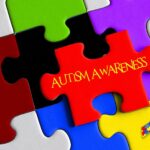Autism Spectrum Disorder (ASD) is a developmental condition that affects communication, behavior, and social interaction. Early detection and intervention can significantly improve outcomes for children with ASD. Understanding the early signs can help parents and caregivers seek support as soon as possible.
What is Autism Spectrum Disorder?
ASD is a neurodevelopmental disorder that manifests in a variety of ways, impacting a child’s ability to communicate, interact, and engage with their surroundings. The Centers for Disease Control and Prevention (CDC) reports that 1 in 36 children in the U.S. is diagnosed with ASD, highlighting the importance of awareness and early intervention (CDC, 2023).
Early Signs of Autism Spectrum Disorder
The early signs of ASD can emerge before a child turns two years old. However, symptoms vary from child to child. Below are some common indicators:
1. Social Communication Challenges
- Limited eye contact or avoidance
- Lack of response to their name by 9-12 months
- Difficulty understanding or expressing emotions
- Limited or absent gestures such as waving or pointing
- Preference for playing alone rather than engaging with peers
2. Speech and Language Delays
- Delayed speech development or absence of speech
- Echolalia (repeating words or phrases out of context)
- Difficulty initiating or maintaining conversations
- Unusual tone, rhythm, or pitch in speech
3. Repetitive Behaviors and Restricted Interests
- Engaging in repetitive movements like hand-flapping, rocking, or spinning
- Strong attachment to specific objects or routines
- Resistance to changes in routine or environment
- Intense focus on specific topics, objects, or activities
4. Sensory Sensitivities
- Unusual reactions to sounds, lights, textures, or smells
- Seeking excessive sensory stimulation, such as spinning objects
- Avoidance of certain sensory experiences, like wearing specific fabrics or eating certain foods
When to Seek Professional Help
If parents notice any of these signs, consulting a pediatrician or a developmental specialist is crucial. The American Academy of Pediatrics (AAP) recommends developmental screenings at 9, 18, and 24 or 30 months to identify potential delays (AAP, 2022).
Diagnosis and Early Intervention
A comprehensive evaluation typically includes:
- Developmental Screening: A short test to determine if a child is learning basic skills at the appropriate age.
- Comprehensive Diagnostic Evaluation: A detailed assessment conducted by specialists, including pediatric neurologists, developmental-behavioral pediatricians, or child psychologists.
Early intervention programs, such as speech therapy, occupational therapy, and Applied Behavior Analysis (ABA), can significantly enhance a child’s development (National Institute of Mental Health, 2023).
Resources for Parents
For parents seeking guidance, the following organizations provide valuable information and support:
- Autism Speaks: www.autismspeaks.org
- CDC Autism Information: www.cdc.gov/ncbddd/autism
- National Autism Association: www.nationalautismassociation.org
Conclusion
Recognizing the early signs of ASD can empower parents to seek timely intervention, providing children with the best opportunity to reach their full potential. By staying informed and proactive, families can access essential resources and support to navigate their child’s developmental journey.
References
- American Academy of Pediatrics. (2022). Developmental surveillance and screening. Retrieved from www.aap.org
- Centers for Disease Control and Prevention. (2023). Autism spectrum disorder: Data & statistics. Retrieved from www.cdc.gov
- National Institute of Mental Health. (2023). Autism spectrum disorder. Retrieved from www.nimh.nih.gov
- Image by Mimzy from Pixabay


